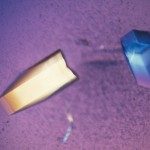Lien vers Pubmed [PMID] – 14764099
Eur. J. Biochem. 2004 Feb;271(4):821-33
The interaction of the adenylate cyclase catalytic domain (AC) of the Bordetella pertussis major exotoxin with its activator calmodulin (CaM) was studied by time-resolved fluorescence spectroscopy using three fluorescent groups located in different regions of AC: tryptophan residues (W69 and W242), a nucleotide analogue (3′-anthraniloyl-2′-deoxyadenosine 5′-triphosphate, Ant-dATP) and a cysteine-specific probe (acrylodan). CaM binding elicited large changes in the dynamics of W242, which dominates the fluorescence emission of both AC and AC-CaM, similar to that observed for isolated CaM-binding sequences of different lengths [Bouhss, A., Vincent, M., Munier, H., Gilles, A.M., Takahashi, M., Bârzu, O., Danchin, A. & Gallay, J. (1996) Eur. J. Biochem.237, 619-628]. In contrast, Ant-dATP remains completely immobile and inaccessible to the solvent in both the AC and AC-CaM nucleotide-binding sites. As AC contains no cysteine residue, a single-Cys mutant at position 75 was constructed which allowed labeling of the catalytic domain with acrylodan. Its environment is strongly apolar and rigid, and only slightly affected by CaM. The protein’s hydrodynamic properties were also studied by fluorescence anisotropy decay measurements. The average Brownian rotational correlation times of AC differed significantly according to the probe used (19 ns for W242, 25 ns for Ant-dATP, and 35 ns for acrylodan), suggesting an elongated protein shape (axial ratio of approximately 1.9). These values increased greatly with the addition of CaM (39 ns for W242, 60-70 ns for Ant-dATP and 56 ns for acrylodan). This suggests that (a) the orientation of the probes is altered with respect to the protein axes and (b) the protein becomes more elongated with an axial ratio of approximately 2.4. For comparison, the hydrodynamic properties of the anthrax AC exotoxin were computed by a mathematical approach (hydropro), which uses the 3D structure [Drum, C.L., Yan, S.-Z., Bard, J., Shen, Y.-Q., Lu, D., Soelalman, S., Grabarek, Z., Bohm, A. & Tang, W.-J. (2002) Nature (London)415, 396-402]. A change in axial ratio is also observed on CaM binding, but in the reverse direction from that for AC: from 1.7 to 1.3. The mechanisms of activation of the two proteins by CaM may therefore be different.

